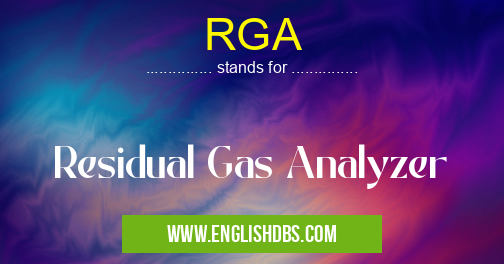What does RGA mean in NASA
RGA stands for Residual Gas Analyzer. It is an instrument used to measure the composition of residual gas in an enclosed space. RGA is widely used by government agencies, research laboratories and manufacturing industries to monitor and analyze the purity of gases in a particular environment. The analyzer helps identify any hazardous or harmful gases present in the atmosphere, thereby ensuring safety for those working within the vicinity.

RGA meaning in NASA in Governmental
RGA mostly used in an acronym NASA in Category Governmental that means Residual Gas Analyzer
Shorthand: RGA,
Full Form: Residual Gas Analyzer
For more information of "Residual Gas Analyzer", see the section below.
» Governmental » NASA
What Is RGA?
An RGA (Residual Gas Analyzer) is a device that measures the concentration of residual gases in an enclosed container. It uses an ionization technique to generate molecular ions which are then analyzed using an electronic mass spectrometer. This data is then used to determine the composition and concentration of various molecules present in a given sample. The device can be used for many different applications including process control, environmental monitoring, safety testing, laboratory analysis as well as reactor diagnostics.
How Does It Work?
An RGA works by measuring the concentration of residual gases present inside a sealed enclosure such as a tank or chamber. A gas sample is first drawn into the instrument through its suction port and introduced into its analysis chamber via a vacuum system. Inside this chamber, electrons are generated through ionization processes which triggers chemical reactions between atoms or molecules forming their respective ions. By measuring these molecular ions with an electronic mass spectrometer, one can determine their composition and relative concentrations within each sample—giving researchers valuable data regarding what kind of molecules are present inside different environments or chambers.
Advantages Of Using An RGA
Using an RGA offers many advantages in terms of safety, efficiency and accuracy compared to other techniques for analyzing gas samples. An RGA can analyze multiple samples at once simultaneously thanks to its ability to take readings from multiple channels at once—saving time and effort when monitoring large areas or systems over long periods of time. In addition, it’s able to provide accurate results quickly due to its low resolution scanning speed—allowing researchers to quickly identify any hazardous materials present in their environment before they become dangerous or cause harm to personnel on-site. Finally, due to its small size and lightweight design it’s easy for workers or technicians to transport the device from one location to another without having to worry about bulky equipment taking up too much space during transit or while traveling away from their primary research site(s).
Essential Questions and Answers on Residual Gas Analyzer in "GOVERNMENTAL»NASA"
What is an RGA?
An RGA (Residual Gas Analyzer) is a type of mass spectrometer used to measure the composition and partial pressure of residual gases in a vacuum system. It can detect gas species from low parts-per-million (ppm) up to atmospheric pressures.
What gases does an RGA measure?
An RGA measures all types of gases, including heavy hydrocarbon molecules, hydrogen, and helium. Depending on the type of analyzer, it may also measure isotopes of the same gas.
How accurate is an RGA measurement?
The accuracy and resolution of an RGA measurement depends on the quality of the instrument. A high-quality analyzer will typically offer concentrations down to 1 part per billion (ppb) with a resolution better than 10%.
What is the difference between an RGA and a quadrupole mass spectrometer?
A quadrupole mass spectrometer utilizes four rods or poles arranged in a “quad” configuration which act as filters to separate ions based on their charge-to-mass ratio. An RGA uses an electron source to ionize all types of molecular species without preselection by charge or mass, so it can detect any type of gas that can be ionized.
How fast can an RGA make measurements?
Most modern RGAs are capable of making real-time measurements over a range from parts per million (ppm) up to atmospheric pressure at relatively high speeds. Depending on the type and model, some can make multiple readings within milliseconds.
Do I need special training to use an RGA?
Operators do not need specialized training in order to use most RGAs; however they should have knowledge of basic vacuum technology and familiarization with relevant safety procedures for handling hazardous gases.
Can I use my existing pumping system with my new RGA?
Yes, many existing pumping systems are compatible with modern RGAs. However, you should consult your specific manufacturer’s instructions for compatibility requirements.
Does using an RGA require periodic maintenance?
Yes, regular maintenance such as cleaning sensors or replacing detectors may be required depending on usage frequency and other environmental factors.
Does context matter when interpreting results from an RGA analysis?
Context certainly has a major impact when interpreting results from an RGA analysis. Factors such as sample temperature, background pressure levels, sample size/composition, etc., can affect results significantly depending upon each individual application.
RGA also stands for: |
|
| All stands for RGA |
